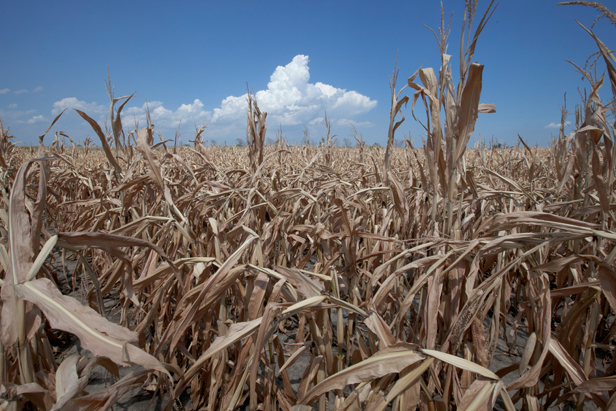Is Climate Change to Blame for the Current U.S. Drought?

High temperatures and extremely dry conditions in much of the United States continue to hurt crops and cause corn prices to soar. In large parts of the Midwest, the drought has reached the worst classification possible, a D4 drought that could bring “exceptional and widespread crop and pasture losses” and “water emergencies” due to shortages in reservoirs, streams, and wells, according to the U.S. Drought Monitor, an organization run by a collection of government and academic groups. The National Weather Service says scattered thunderstorms will bring little relief, and suggests that the drought will worsen.
Many climate models suggest that heat waves and droughts will increase as greenhouse-gas levels increase in the atmosphere (see “Planning for a Climate-Changed World” and “How Coders Can Help Fight Climate Change”). But are the current conditions—and other extreme weather like the drought in Texas last year—related to climate change?
Technology Review asked a prominent climate scientist, Thomas Karl, director of the National Climatic Data Center in Asheville, North Carolina, to weigh in.
1. What’s causing the recent heat waves and droughts?
This heat wave has a contribution from human activities, and you can expect these kinds of things to become even more extreme during both your and my lifetimes as we continue to increase greenhouse gases. As temperatures warm, they affect extreme weather events. It’s quite clear that we’re seeing, not only here in the U.S., but across the globe, events that we’ve never before witnessed in our instrumental record, and it’s quite apparent there’s a human contribution.
2. The connection between global warming and heat waves is obvious. What’s the connection between increased temperatures and drought?
In the drought in Texas last year, the extra heat evaporated more water, and that then made the drought more intense, so there was a bit of a feedback effect. But also, there are changes in the patterns of precipitation. If you’re in the subtropics, those are areas that are going to get drier as subtropical weather systems move north in response to warmer temperatures, and the jet streams move north.
You actually see more precipitation in the mid and high latitudes like Canada and the northern U.S. border, less precipitation in the southwestern U.S. and along the subtropics. You’re seeing a whole shift in the atmospheric circulation system. But the models aren’t as clear in terms of precipitation as they are for temperature. I suspect it will be really difficult to show how much these changing patterns contributed to the drought in the Midwest this year.
3. Climate scientists have been reluctant to make connections between specific weather events and climate change. But a recent study on the Texas heat wave from your organization suggested it was 20 times more likely. Why are scientists making more specific claims now?
People latch on to statements like the heat wave was 20 times more likely. But there were caveats in the study. The important statement there is that the heat wave was stronger than it otherwise would have been were it not for the burning of fossil fuels and the increase in greenhouse gases.
These studies are possible today because you have faster computing. You couldn’t do this five to 10 years ago. You need to run models numerous times to get the right number of samples. Also, the data are much more easily available now. And, quite frankly, the signal, the climate signal from greenhouse gases and human activities, continues to get stronger. When the levels of greenhouse gas are higher, it becomes easier to say that certain kinds of events are going to be more intense.
Keep Reading
Most Popular
Large language models can do jaw-dropping things. But nobody knows exactly why.
And that's a problem. Figuring it out is one of the biggest scientific puzzles of our time and a crucial step towards controlling more powerful future models.
How scientists traced a mysterious covid case back to six toilets
When wastewater surveillance turns into a hunt for a single infected individual, the ethics get tricky.
The problem with plug-in hybrids? Their drivers.
Plug-in hybrids are often sold as a transition to EVs, but new data from Europe shows we’re still underestimating the emissions they produce.
Stay connected
Get the latest updates from
MIT Technology Review
Discover special offers, top stories, upcoming events, and more.